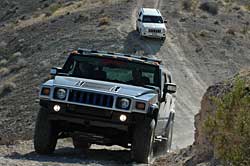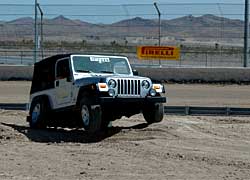March 21, 2006
Vehicles Used
Jeep Wrangler LT245/75R16
Lexus GX470 P265/65R17
Ford F-150 P275/55R20 (Original
Equipment)
Cadillac Escalade P305/45R22
Hummer H2 LT325/45R24
The Scorpion ATR is Pirelli’s On-Road All-Terrain light truck tire developed for pickup truck and sport utility
vehicle drivers that want on-road civility along with off-road capability. Initially used as Original Equipment
on Ford F-150 FX4, Lariat, and King Ranch models, as well as the Lincoln Mark LT, the Scorpion ATR is now
available in a range of traditional light truck sizes, as well as extends All-Terrain Performance into the large
rim diameter tuner sizes appropriate for today’s street/sport trucks.
Because the availability of the Scorpion ATR’s expanded size range preceded our 2006 test season in South Bend,
members of Tire Rack Team were invited to experience the Scorpion ATR at a ride & drive conducted by Pirelli
for journalists and tire dealers on the highways and desert north of Las Vegas, as well as at the Las Vegas
Motor Speedway.
Our first impression of the Scorpion ATR’s evolution was its expanded size range. Arriving at the Speedway, we
saw test vehicles ranged from the Jeep Wrangler to the Lexus GX470, Ford F-150, Cadillac Escalade, and Hummer
H2.
While no direct competitive tire comparisons were possible, the Scorpion ATR showed its on-road civility during
our 35-mile trip from the Las Vegas Motor Speedway to Nevada’s Valley of Fire State Park. The tire’s combination
of ride comfort, noise level and highway tracking on Interstate 15 was noted and its responsiveness and
cornering capability along the twisting park roads was commendable. The Scorpion ATR later showed its off-road
capability as it easily crawled up and down the terrain when we traveled some rock-strewn trails.
During our return to the Speedway, we encountered a hailstorm that blanketed the road and the surrounding
landscape with pea-size hail for a short time. While it didn’t take long for the hail to be melted by contact
with the warm earth and ensuing rain, neither condition appeared to faze the tires.
Once back at the Las Vegas Motor Speedway, we had the opportunity to drive slowly through an off-road course
sculpted in the dry infield of the Speedway’s half-mile clay oval. This gave us the opportunity to experience
the tires’ traction up and over steep manmade inclines and descents, as well as feel their resistance to
slipping sideways when driving across slopes. In all cases the tires performed as anticipated, exhibiting little
wheelspin and sideslip.



